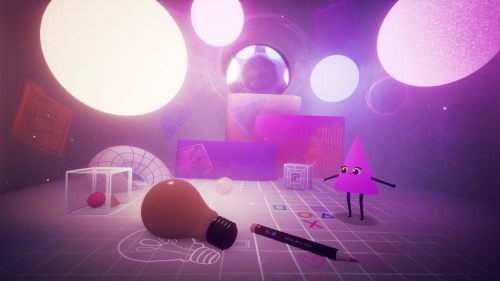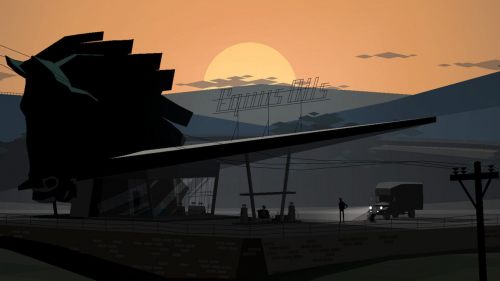Game Review: TEARAWAY UNFOLDED Is Cute, Clever Craftwork
That Media Molecule has become such a success story is one of the game industry’s little miracles. Through a publishing deal with Sony, the studio’s “Play, Create, Share” ethos not only made its debut Little Big Planet a hit, but changed the face of video games. It’s arguable that Minecraft and Super Mario Maker would not have been quite as successful without Little Big Planet laying the groundwork. The studio’s next title, Dreams, looks to reinvent the paradigm yet again, with a brand-new, freeform approach to in-game creativity.
And then in between Little Big Planet and Dreams, we have Tearaway. Originally developed for the PlayStation Vita handheld console, Tearaway was a more traditional platformer than Media Molecule’s other games, but still retained more than a whiff of its creative spirit. It gained enough praise and success to be remade for the PlayStation 4, and here we are.
Straight away, Tearaway Unfolded is a game about telling stories. The dual male and female narrators lament the lack of good stories, so it’s up to you and the game to make one together. Luckily, an opportunity quickly presents itself, as a portal opens up between the game world and “The You’s world” (i.e. reality - you are The You), releasing nasty cyclopean monsters called Scraps into it. Your character, plucky messenger Atoi (or Iota, if you play as a male), must then deliver a message through the portal and save the game world. The story that plays out is well-written and laden with wordplay, with narration delivered by Richard Ridings and Alicia Suszka-Fielder with the energetic zest of consummate storytellers.
Atoi’s adventure taks her through a gorgeous, varied world where everything is made of paper. That’s actually more literal than it sounds: the game engine operates such that everything in it can technically be crafted out of paper, and you can unlock printable papercraft models of the game’s characters and objects (a wonderful touch). The textures, colours, animation, and - Christ - the rustly papery sound effects are so satisfying to play in. It feels tactile in a way that photorealism can’t even approach.
What you actually do in Tearaway Unfolded broadly follows a quest structure, with a variety of gameplay modes along the way. You’ll hop between platforms, roll through pinball-machine contraptions, and solve puzzles across papery landscapes from icy peaks and rocky shores to desert mesas and spooky forests. The story develops in a delightfully sly manner, as the Scraps’ plan (involving the DualShock 4) is revealed. As you progress, you’ll have opportunities to do short sidequests for amusing characters scattered around the world. Sadly, many of these get repetitive, with a few exceptions like performing aerial stunts for a film crew, or finding and taking a selfie with a lost oceanic explorer.
Much like the original version was with the Vita, Tearaway Unfolded is a game designed around the DualShock 4 controller. This plays out in gameplay - get ready to use the controller’s accelerometer, touchpad, and light bar in inventive ways - and also in the story. You’ll point your controller at the screen to illuminate dark areas; use the touchpad to draw new papercraft designs and control the wind; and even use your microphone to create sound effects for playback in-game. The game's best moments involve using several of these ideas in concert. Many of these moments involve battling the evil Scraps in ways that feel nicely devious. I didn’t use the mobile app that lets you decorate the levels with your own images, though; it felt like I’d be destroying the work of the level artists.
Media Molecule’s penchant for creativity and sharing isn’t as significant in Tearaway as it is in, say, Little Big Planet, but it’s there. Your character can be customised and redesigned at any time using a simple point-and-paste interface, and throughout the game you’ll get to draw new items to add to your getup. To show off your creation, there’s an in-game stills camera you can use to take and share selfies of your custom-decorated messenger. It actually operates on very similar terms to real-life cameras, even going so far as to feature a “nifty fifty” lens option. The same quality doesn’t extend to the third-person camera used in play, however, which frequently gets stuck behind objects, obscuring your view of the action.
If I have any significant complaint about Tearaway Unfolded, it’s that it's just too long. To hell with “value for money” - bad pacing is bad pacing, and this pacing is bad. There’s a ton of variety in the game; it’s just that every idea is repeated over and over, and it’s hard to stay interested when you’re fighting a bunch of Scraps for the hundredth time. More than once it feels like the game builds to a climax or ending, only to drop down depressingly into a new area. If the game was tightened up, it’d be a constant parade of new ideas, new imagery, and new delights. On the other hand, I marathonned through for my review; played chapter by chapter like it’s designed, there wouldn’t be the same sense of grind.
The ending's worth the grind, though. Rarely have I seen a game bring together reality-bending abstraction, narrative, and metanarrative so elegantly (or cutely). The ending is a culmination of all that’s come before - you’re literally presented with a tribute to your achievements - but it’s more than that, too. Tearaway Unfolded’s core - brought out through its story, visual design, and gameplay - is about storytelling, and more specifically the relationship between storyteller, character, and audience. In game terms, that's the link between the player character and the player, explicitly using the controller as a conduit between worlds. The controller gimmicks, fourth-wall-tearing story, and character customisation make you feel connected to the game in a rather profound way, and in the end, it’s surprisingly moving.
Pacing issues and minor quibbles aside, I had a lovely time with Tearaway Unfolded. The variety in environments and platforming mechanics, the music, the puzzles, the gibberish speech, and the sheer exuberant fun of it all bring to mind classic platformers like Banjo-Kazooie, which is a serious compliment coming from me. The joy of discovery is near-omnipresent in this game, and much of it encourages creativity. That’s something games are uniquely well-suited to doing, and the fact that Media Molecule embraces it wholeheartedly brings warm feelings to my heart. It’s gaming at its purest and most joyful.
Bring on Dreams.



